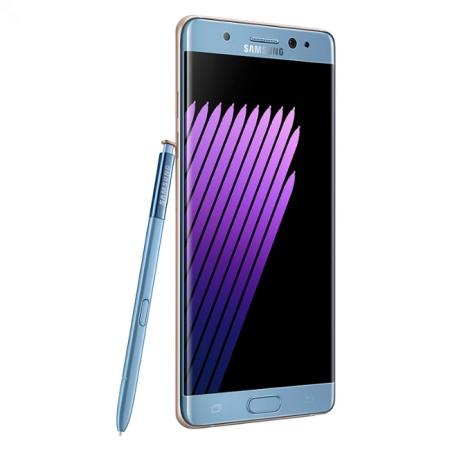
Samsung unveiled the new Galaxy Note7 in New York on Tuesday. Within hours of the launch, the new flagship phablet has received rave reviews from tech pundits across the world.
Though Samsung has skipped the Note6 moniker for the sake of unifying the Galaxy S7 numerical series, many appreciate the company for incorporating a host of new features to justify the name — Galaxy Note7 — as it has no resemblance in any aspects to its predecessor.
To provide a clear perspective between the two Galaxy Note siblings, we have done a quick specification rundown of Galaxy Note7 and its predecessor, the Galaxy Note 5.
Design, display and build quality:
The Galaxy Note7 comes with completely new design language. It boasts a dual-edge display wherein the phone's screen will extend towards the edge on both the right and the left side, unlike its predecessor, which came with plain flat display panel.
The Galaxy Note7 boasts a 5.7-inch QHD (2560x1440p) screen having pixel density of 518 ppi (pixels per inch) and protected by Corning's latest Gorilla Glass 5 shield. It is the world's first device to boast such a display protection guard.
Though its predecessor features the same screen size, its resolution is 515 ppi and it is protected by Gorilla Glass 4.
The company, in a bid to increase the durability, has incorporated a blend of high-grade glass and metal in Galaxy Note7 with IP68 water-resistant certification. This allows the owners to use the device under water for close to 30 minutes. Even the S-Pen stylus can also be used in wet conditions.
It also brought back one key feature — the micro SD card slot, which was sorely missed in the 2015 model.
On the other hand, the Galaxy Note 5 featured a full metal-body, which apparently forced Samsung to ditch the micro SD card slot and water-proofing feature.
The Galaxy Note7 measures 153.5 x 73.9 x 7.9mm in dimensions and weighs 168g, 3g lesser than the Galaxy Note 5. The former is a tad bulky and measures 153.2 x 76.1 x 7.6 mm.
Processor, RAM and storage:
In 2015, Samsung launched the Galaxy Note 5 with only one variant featuring its own 14-namometer class based 64-bit Octa-core Exynos 7420 CPU (quad-core 1.5 GHz Cortex-A53 + quad-core 2.1 GHz Cortex-A57) with 4GB RAM and 32GB/64GB inbuilt storage (no micro SD slot).
The company had ditched Qualcomm's Snapdragon 810 CPU, as it was plagued by over-heating issues.
This year, Qualcomm's new Snapdragon 820 quad-core processor had no such issues. Samsung even used it in the Galaxy S7 series and now, it has also been incorporated in the Galaxy Note7 bound for the U.S. and other select developed markets.
In the other regions (including India), the Galaxy Note 7 will come packed with 14nm-based 64-bit class Samsung Exynos 8890 series octa-core CPU.
Both the Galaxy Note7 models come with 4GB RAM and 64GB (UFS 2.0) inbuilt storage with option for expansion up to 256GB.
Camera:
In 2015, Galaxy Note 5 and Galaxy S6 were touted by critics as the best camera phones in the smartphone industry.
Both the devices feature 16MP camera with F1.9 apertures, an array of dedicated photography apps and an equally impressive 5MP snapper on the front.
Now, Samsung has incorporated the same camera hardware as seen inside the Galaxy S7 series, which set the benchmark this year.
The Galaxy Note7 boasts Dual-Pixel 12MP camera with f/1.7 aperture and smart OIS (Optical Image Stabilization) feature.
Many might wonder why Samsung would lower the MP count in its flagship phone from 16MP seen in the Galaxy Note 5 series to 12MP in its successor.
Well, this is actually a myth. Higher MP count doesn't necessarily guarantee a nice image. There are other aspects, which help in capturing good quality pictures. Aperture and lens size are two such key parameters that are considered while designing a good camera and Samsung plans to deliver the same in the Galaxy Note7 and S7 series.
Battery:
Due to design limitations, the company had reduced the battery capacity of the Galaxy Note 5 to 3000mAh from 3,220mAh in the Note 4.
This year, the company has incorporated a bigger 3,500mAh cell in the Galaxy Note7, which we believe is enough for the phone to last a whole day easily, under moderate usage.
The new phone's battery supports fast charging on both wired and wireless modes.
Value-added features:
Samsung Galaxy Note7's Iris recognition feature sets a new benchmark in smartphone security:
In addition to the fingerprint sensor on the home button, Galaxy Note7 houses an Iris scanner on the top-left corner in the front display panel.
Iris recognition is said to be a more advanced and near-foolproof security system, as it involves capturing the detailed nerve pattern on the iris in the eye, which is unique to each individual.
Using this information, digital impressions are created by mathematical and statistical algorithm so that an accurate profile is created. This new-age biometric technology is nearly impossible to be cracked by an imposter, unlike finger-print scanner that can be bypassed with a fake thumb print.
The Iris recognition camera is also assisted by the IR laser emitter, which helps the device's camera to pin-point the device owner's eyes under low light conditions. It is even capable of mapping the iris pattern when the user is wearing glasses.
Samsung claims that the Galaxy Note7 users can use the iris security feature to make purchases online and lock apps (and folders) containing sensitive information in the phone.
Improved S-Pen:
Samsung Note7's stylus with 0.79mm tip has more sensitivity, gesture controls, and Air command.
To enhance the experience with the stylus, the company has added Samsung Notes, a new unified app allowing users to jot down handwritten notes, draw, or edit memos from one location.
It also boasts IP68 certifications, enabling users to write on the 'Always On' Galaxy Note7 display while swimming as well.
Read more: Samsung Galaxy Note7 release details
Key features of the Samsung Galaxy Note7 and Galaxy Note 5:
| Models | Galaxy Note7 | Galaxy Note 5 |
| Display | 5.7-inch QHD(2K)-based dual-edge curved screen with 2560x1440p resolution, Always-On feature and come with Corning's Gorilla Glass 5 series protections
|
5.7-inch WQHD (2560x1440p) super AMOLED screen, Gorilla Glass 4
|
| OS | Android 6.0.1 Marshmallow | Android 5.1.1 Lollipop |
| Processor | Model 1: 14nm based 64-bit class Qualcomm Snapdragon 820 CPUModel 2: 14nm based 64-bit class Samsung Exynos 8890 series Octa-core CPU | 14-namometer class 64-bit Octa-core Exynos 7420 CPU (Quad-core 1.5 GHz Cortex-A53 & Quad-core 2.1 GHz Cortex-A57) with Mali-T760 |
| RAM | 4GB RAM (LPDDR4) | 4GB LPDDR 4 series |
| Storage | 64GB (UFS 2.0), expandable up to 256GB | 32GB/64GB |
| Camera |
|
|
| Battery | 3,500mAh (Fast Charging on wired and wireless)
|
3,000mAh, Fast Charging both on wired and wireless
|
| Network | LTE Cat.12 / LTE Cat.10 / LTE Cat.9 (depends on the region of sale) | 4G-LTE (Cat. 9 or Cat. 6) depending on the regional network |
| Add-ons | Iris scanner, fingerprint sensor, IP68 water-and-dust resistant certifications, Wi-Fi 802.11 a/b/g/n/ac (2.4/5GHz), MIMO(2x2) 620Mbps, Bluetooth v 4.2 LE, ANT+, USB Type-C, NFC (Near Field Communication), location-based -GPS, Glonass, Beidou, Barometer, Gyro Sensor, Geomagnetic Sensor, Hall Sensor, HR Sensor, Proximity Sensor, RGB Light Sensor S-Pen features: S Memo, GIF animations with Smart Select, Air Command functions, Magnify, Translate, Samsung Notes, a new unified app allowing users to jot down handwritten notes, draw, or edit memos from one location. | Finger print-sensor, new advanced S-Pen stylus, WiFi 802.11 a/b/g/n/ac, MIMO(2x2), Bluetooth v 4.2 LE, ANT+, USB 2.0, NFC, Location |
| Dimensions | 153.5 x 73.9 x 7.9mm | 153.2 x 76.1 x 7.6 mm |
| Weight | 169g | 171 g |

















